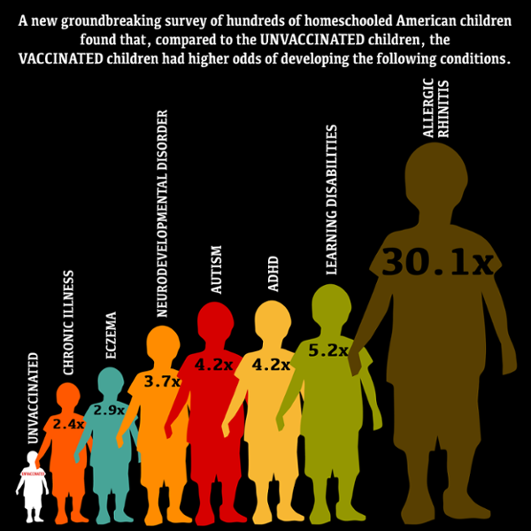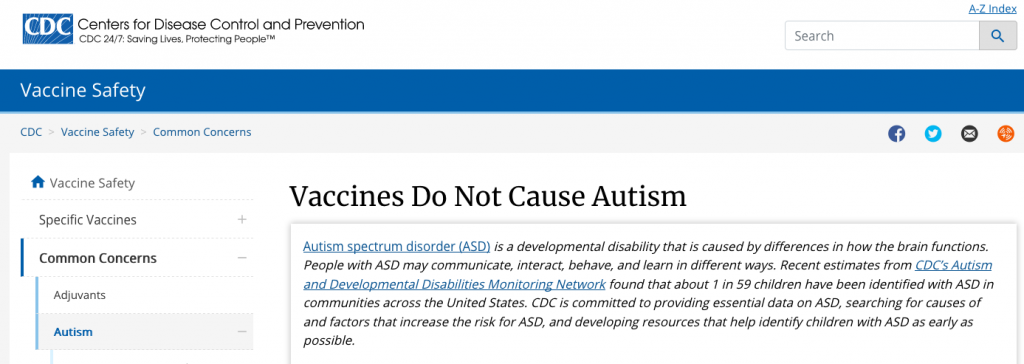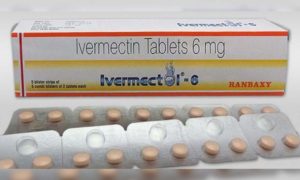Do Vaccines Cause Autism?

The US Center for Disease Control and Prevention (CDC) makes it very clear on their website:
They state very clearly that “Vaccines do not cause autism.” They even link to two studies to supposedly prove that point.
But the CDC just lost a lawsuit forcing them to admit that it has no studies to support the claim that DTaP, HepB, Hib, PCV13 and IPV vaccinations do not cause autism. And the studies they link to do not support such a bold claim. The first states:
The committee finds that evidence convincingly supports a causal relationship between some vaccines and some adverse events—such as MMR, varicella zoster, influenza, hepatitis B, meningococcal, and tetanus-containing vaccines linked to anaphylaxis. Additionally, evidence favors rejection of five vaccine-adverse event relationships, including MMR vaccine and autism and inactivated influenza vaccine and asthma episodes. However, for the majority of cases (135 vaccine-adverse event pairs), the evidence was inadequate to accept or reject a causal relationship. Overall, the committee concludes that few health problems are caused by or clearly associated with vaccines.
Besides the MMR and autism relationship, the study says there isn’t enough data to make a decision one way or the other. Unfortunately for public health, the CDC has decided that no news is good news: we don’t know if it’s harmful so we’re going to say that it’s not.
This is where the godfather of vaccines, Stanley Plotkin, is forced to rationalize that he could not as a scientist or logician say that vaccines don’t cause autism but that as a physician he could tell parents that. The following is an excerpt from the sworn deposition of Stanley Plotkin in 2018:
Mr. Siri: Okay. So, and after conducting that review, they found that there was no evidence at all that they could find whether DTaP or Tdap caused autism. I’m just asking you a simple question, which is since there’s no evidence whether DTaP or Tdap cause autism, isn’t it a little premature to say, to make the sweeping statement that vaccines do not cause autism?
Dr. Plotkin: No, I do not agree with that. Because absence of evidence works both ways. There’s no evidence that they do, and the ideal study has not been done. I agree with that. But in the absence of any reasonable evidence that they do, I continue to recommend their use.
Mr. Siri: So you’re willing to make a statement that a vaccine does not cause a condition even in the absence of any evidence?
Dr. Plotkin: I’m willing to state that there is no evidence that the vaccine causes the condition and, therefore — and there is a lot of evidence that they do protect against disease. And, therefore, the child should receive the vaccines.
The second study that the CDC cite is wrought with problems and is as CDC critic Dr. Hooker said, “The Destefano et al. 2013 study is to science what the movie Ishtar was to cinema.” The main problems he contends are that there was no new data, no true control, high participant refusal, and a problem with overmatching.
Epidemiological Studies
The main problem with these studies and the others that supposedly vindicate all vaccines with relationship to autism is that they have not looked at the difference between vaccinated and a fully unvaccinated population. They use the term “unvaccinated” to mean a person without the vaccination in question for that particular study, which has been consistently just the MMR vaccine.
When a study that did compare vaccinated versus fully unvaccinated people was conducted (The Mawson Study), it showed that vaccinated population were four times as likely to have autism. Granted, this study was considered a pilot study because of the small sample size, but the findings were statistically significant and presents a clear signal, raising the question of why this study hasn’t been duplicated on a larger scale.

The answer to that may be because the medical establishment may not like what they find in a vaccinated-versus-completely-unvaccinated study. Instead, they promote studies (like this Danish study) that focus on one vaccine (MMR) and claim that vaccines don’t cause autism because there was no correlation between MMR and the disorder even though subjects received other vaccines in the study. As the study author Anders Hviid said, “The idea that vaccines cause autism is still around despite our original and other well-conducted studies. Parents still encounter these claims on social media, by politicians, by celebrities, etc.” Hviid didn’t cite the other studies because there aren’t any. Safety studies for vaccinations on the CDC schedule have never included a true placebo group much less a group of completely unvaccinated subjects.
Moreover, these studies are just epidemiological and are subject to data manipulation (several data were inexplicably thrown out of the MMR study). If a vaccine or a series of vaccines cause autism, this should be shown in biological studies. As JB Handley has explained in How to End the Autism Epidemic, the science has been done and it points to vaccines as a contributor to the autism epidemic.
Biological Science
Here are the most important studies that point to a vaccine-autism link:
1: “Maternal Immune Activation” can cause autism. A study from 2007 saw an increased risk of autism in rodents:
Maternal immune activation (MIA) in pregnant rodents produces offspring with abnormalities in behavior, histology, and gene expression that are reminiscent of schizophrenia and autism, making MIA a useful model of the disorders…Here we show that the cytokine interleukin-6 (IL-6) is critical for mediating the behavioral and transcriptional changes in the offspring.
2. Administration of aluminium to neonatal mice in vaccine-relevant amounts is associated with adverse long term neurological outcomes. This study from 2013 showed that the aluminum adjuvant used in vaccines cause a similar immune activation as in the 2007 study but in newborn subjects as well.
3. Aluminum also produced autism-like behavior in sheep. A study from 2018 showed that sheep also react to aluminum adjuvants in a similar way:
Vaccine and adjuvant-only groups demonstrated significant changes in the interindividual and intragroup interaction patterns (ie, increase in wool biting and restlessness) as the cumulative number of injections increased. These findings coincide with previous observations on the ovine ASIA syndrome. Treatment groups also showed higher levels of stress biomarkers, and the clinicopathological picture as a whole showed few significant differences between these groups. These results will be published in detail elsewhere.
4. Hepatitis B vaccine, which includes the aluminum adjuvant, induces IL-6 in postnatal rats. A study from 2015 showed that the Hep B vaccine that is given to newborns within 24 hours of birth increases IL-6 cytokines , which were linked to autism in study 1 above.
5. Hep B vaccine increases autism in human boys. This study from 2008 showed an increased risk of autism in boys who received the hep B vaccine. It also showed a decreased risk of autism in girls, ironically (see below about the sex differences in autism rates).
6. People with autism have higher levels of aluminum in their brains. This study showed that people with autism have higher levels of aluminum in the brain:
These are some of the highest values for aluminium in human brain tissue yet recorded and one has to question why, for example, the aluminium content of the occipital lobe of a 15 year old boy would be 8.74 (11.59) μg/g dry wt.?
7. People with autism have higher levels of certain immune cells in their brains.
Injected Aluminum Creates Brain Inflammation
The most likely theory right now is that, while vaccine manufacturers assume that injected aluminum is safe because we ingest dietary aluminum at much higher rates through the mouth, aluminum is in fact what causes infantile brain inflammation, which in turn leads to autism. The aluminum is transported to the brain from injection site through a Trojan Horse effect that Vaccine Papers explains well:
Before the Al adjuvant nanoparticles dissolve, they are eaten (“phagocytosed”) by MFs. The MFs then carry the Al nanoparticles around the body, including into the brain. MFs can pass through the BBB when inflammation is present. Aluminum at very low levels causes inflammation in the brain. Aluminum stimulates elevated production of the cytokine interleukin-6 (IL-6). Elevated IL-6 causes autism.
It’s important to note that this Trojan Horse effect only works with low doses of injected aluminum adjuvant. High doses result in local granulomas at the injection site. Low doses do not trigger granuloma and instead or transported throughout the body including to the brain.
Autism Sex Difference
There is a wide gap in autism diagnosis between male and female children. This could be explained by the well-documented differences in immune response between male and female children:
Sex differences in immune responses result in differential susceptibility of males and females to autoimmune diseases, malignancies and infectious diseases, as well as affecting the outcome of vaccination.
But if, “females develop more frequent and severe adverse reactions, including fever, pain and inflammation to vaccines,” wouldn’t that mean that they should have a higher incidence of autism due to the inflammation? If the female response is more immediate and local, this would explain how the adjuvant could be contained locally and not permitted to be transported to the brain.
A 2019 study may have the key. It shows that both male and female mice show an increase in neuroinflammatory factors after an immune activation, but that males show a decrease in anti-inflammatory factors and females an increase in anti-inflammatory factors. The results matched the human population. This further supports the immune-activation-autism link and explains one of the biggest mysteries of the disease.
Conclusion
The evidence is mounting despite intense pushback from the pharmaceutical industry. It appears that vaccines—especially those with the aluminum adjuvant—create an immune activation and inflammation in the brain correlated with IL-6 and IL-17cytokines. This brain damage during crucial developmental stages leads to autism spectrum disorder in some children. More science needs to be done, clearly, but it is safe to say that the CDC is wrong and that vaccines do cause autism.




